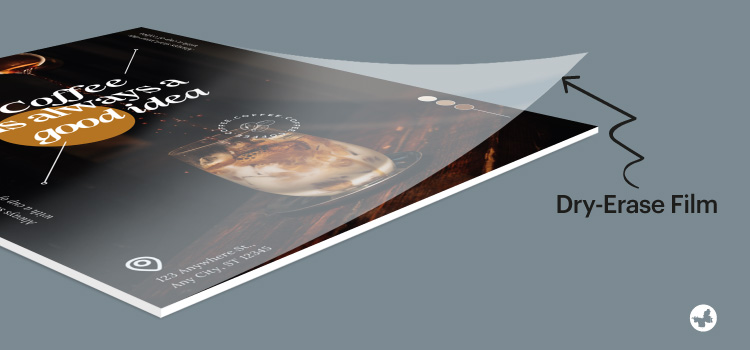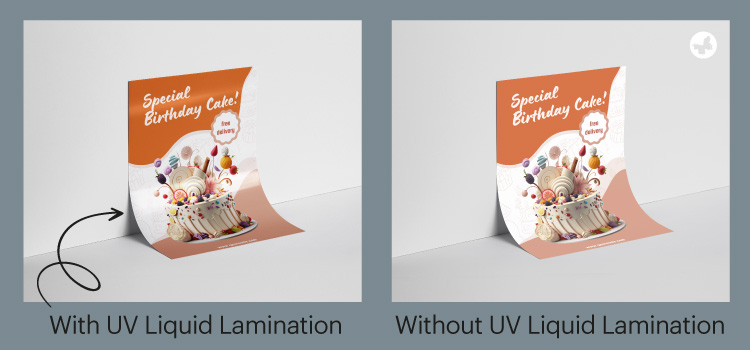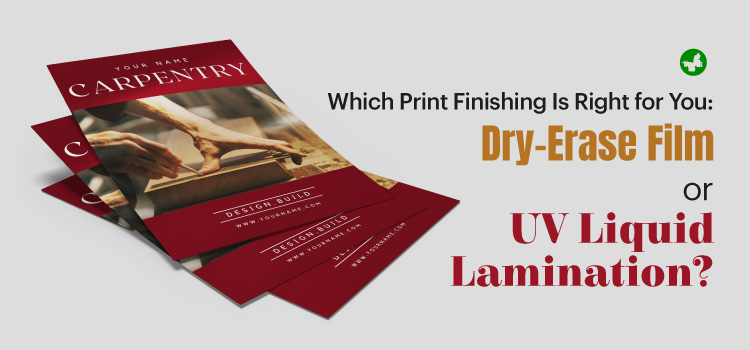In the ever-expanding world of print finishing, choices abound, making decisions seem daunting. Among the key methods are dry-erase film and UV liquid lamination. The technique you select will largely depend on the purpose of your print project and your specific requirements. Nevertheless, the essential question remains: which print finishing is right for you?
Contents
Dry-Erase Film

The dry-erase film is a type of overlay that can be applied to printed materials, creating a writeable and wipeable surface. It is optimal for materials where you will need to regularly update information without damaging the underlying print. Here’s a closer look at the dry-erase film application process, its benefits, and potential drawbacks.
Read More: Top 4 Cardstock Thickness for Your Needs
The Process
The application technique of the dry-erase film is quite simple. First, the film is laid over the print. Next, it passes through a machine that uses heat and pressure to bond the film to the print. Consequently, this process ensures longevity and resistance to wear and tear.
Pros of Dry-Erase Film
- Reusability: The dry-erase film is built to last, and its surface is resistant to scratches and spills making it reusable for a long period.
- Flexibility: You can use a range of dry-erase markers on it without causing any damage, and any changes you make can be easily wiped off.
- Professional Appearance: With a glossy finish, dry-erase film offers a professional look that is often desired in business settings.
Cons of Dry-Erase Film
- Susceptibility to Heat: Dry-erase film can warp and peel in extreme heat. Hence, its usage in outdoors or high-temperature areas is limited.
- Cost: Applying dry-erase film is more expensive than using standard lamination due to the specialty film used.
UV Liquid Lamination

UV liquid lamination is a unique finishing technique popular for outdoor signage. Let’s delve deeper to understand its process of application, advantages, and possible disadvantages.
The Process
Apply UV liquid lamination to a printed product using either a roller or spray. Then, dry or cure the product with ultraviolet (UV) light. As a result, the finish creates a durable, protective layer that withstands harsh outdoor environments.
Pros of UV Liquid Lamination
- Durability: UV liquid lamination offers excellent durability, making it resistant to environmental factors like direct sunlight, rain, or wind.
- Fade Resistance: The UV inhibitors in the liquid laminate help protect prints from fading due to sun exposure. This makes it perfect for outdoor signage.
- Cost-Effective: UV liquid lamination can be a cost-effective choice, depending on the volume and size of the print job.
Cons of UV Liquid Lamination
- Application Difficulty: Applying UV liquid lamination is a complex process that requires experienced operators and specialized equipment.
- Limitation on Material: UV liquid lamination is not suitable for all types of materials. It works best on rigid substrates like clear acrylics and polycarbonates.
Making the Choice: Dry-Erase Film or UV Liquid Lamination?
Choosing between dry-erase film and UV liquid lamination is not a matter of which technique is better, but rather what purpose you want to achieve with the finished print.
Opt for dry-erase film if you need to write and erase content frequently. Specifically, it is ideal for planning boards, calendars, brainstorming notes, or restaurant menus, where you regularly update information.
On the other hand, UV liquid lamination is a suitable choice for outdoor materials or items exposed to harsh environmental conditions. For example, this includes outdoor signs, vehicle wraps, banners, or exhibition graphics that need to withstand the elements.
While making your decision, you should also take into account budget constraints and the availability of skilled personnel. Consequently, these factors will significantly influence the feasibility of your chosen print finishing.
Read More: How to Choose the Perfect Material for Large-Format Signs?
Conclusion
In conclusion, neither dry-erase film nor UV liquid lamination is inherently superior to the other. Instead, their effectiveness largely depends on the specific requirements of your print job. Therefore, understanding your unique project needs is crucial for selecting the ideal print finish. Moreover, ensure that the finish enhances your print rather than detracts from it. Ultimately, the best approach is to match the finish to the project’s intent, budget, and setting.
